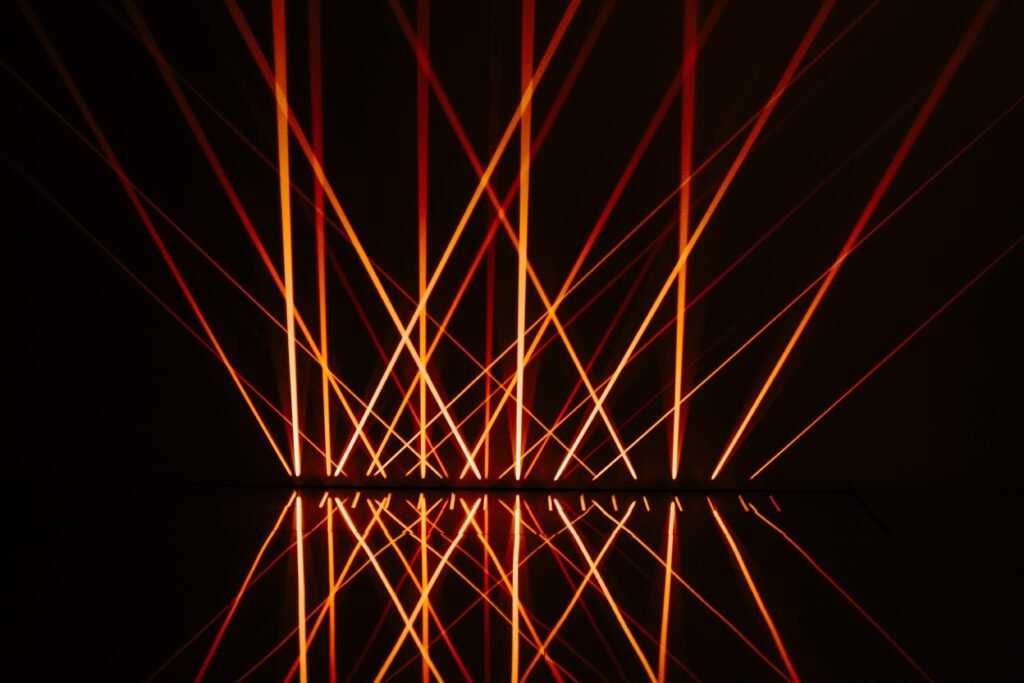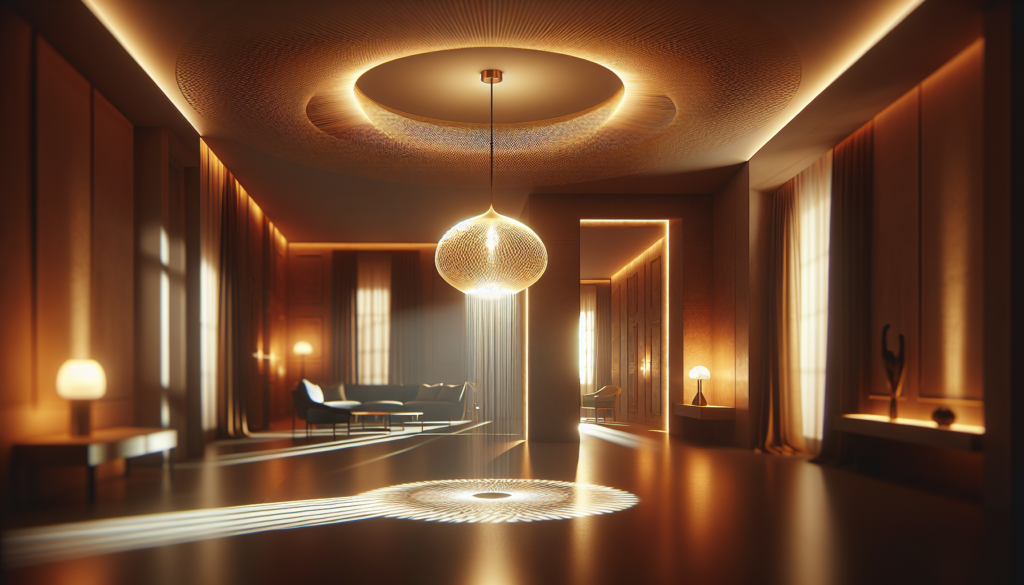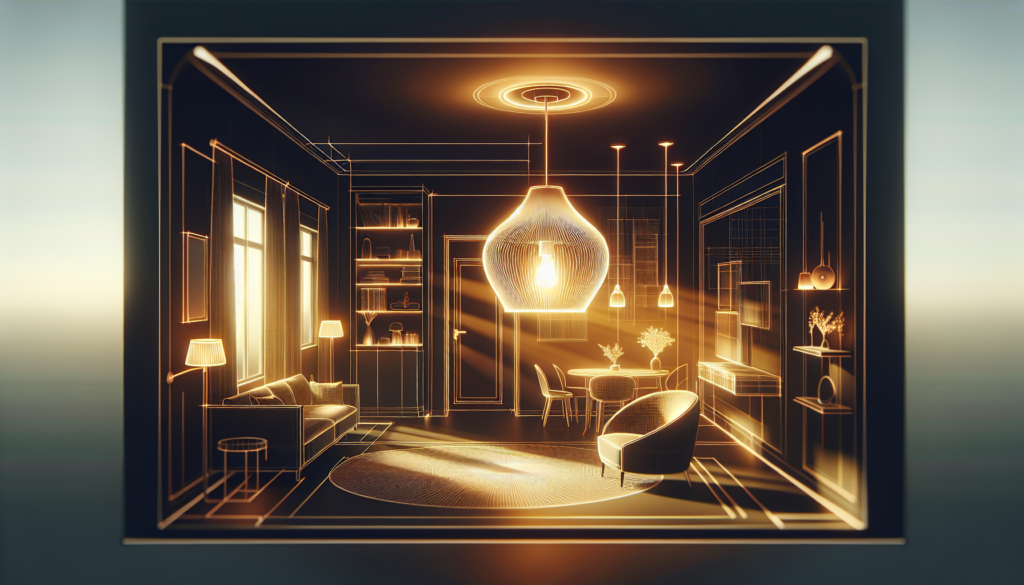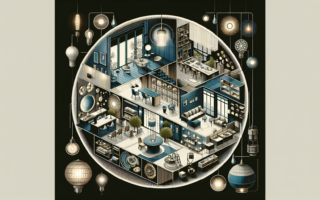Ready to transform your space into a haven of warmth and style? Look no further than “Illuminate Your Space: Lighting Design Concepts.” In this article, you’ll discover a treasure trove of captivating lighting ideas that will help you create the perfect ambiance in any room. From intricate pendant lights that illuminate with artistic flair to sleek modern fixtures that add a touch of sophistication, we’ve got you covered. Get ready to bring your space to life with perfectly curated lighting designs that will leave you basking in the glow of your own creation.

Importance of Good Lighting
Enhances the Mood
Good lighting has the incredible power to enhance the mood and atmosphere of any space. Whether it’s a cozy living room or a vibrant restaurant, the right lighting can create a welcoming and pleasant ambiance that instantly uplifts your spirits. Imagine stepping into a dimly lit room with warm, golden lights. The soft glow creates a soothing and relaxing atmosphere, perfect for winding down after a long day. On the other hand, bright and vibrant lights can energize and invigorate a space, making it ideal for social gatherings or productivity. With the right lighting, you can easily set the mood to match the purpose or desired ambiance of any room.
Creates Ambiance
Lighting is an essential tool for creating ambiance in any space. Different lighting techniques and fixtures can completely transform the look and feel of a room. For example, using soft, diffused lighting can create a romantic and intimate atmosphere in a bedroom, while using bold, focused lighting can add drama and elegance to a dining area. The strategic placement of lights and the use of dimmers can also create versatile spaces that can adapt to different activities or moods. By carefully selecting and arranging lighting elements, you can create the perfect ambiance that complements your personal style and enhances the overall aesthetic of your space.
Increases Functionality
In addition to setting the mood and creating ambiance, good lighting also plays a crucial role in increasing functionality in any space. Imagine working in a poorly lit kitchen where it’s difficult to see the ingredients or properly chop vegetables. Insufficient lighting can not only be frustrating but also pose safety hazards. On the other hand, a well-lit kitchen with task lighting placed strategically over the countertops and cooking areas makes meal preparation much easier and safer. Good lighting is essential for performing tasks efficiently and effectively in any space, whether it’s a home office, bathroom, or workshop. By providing adequate illumination, you can improve productivity, reduce eyestrain, and accomplish tasks with ease.
Highlights Architectural Features
Lighting can be used as a design element to highlight and accentuate the architectural features of a space. Whether it’s a grand staircase or an intricate ceiling design, the right lighting can draw attention to these elements and make them the focal points of the room. A well-placed spotlight or an uplight can create captivating visual effects, casting intriguing shadows and emphasizing textures and patterns. Architectural lighting not only adds a touch of elegance and sophistication to your space but also brings out the unique character of the design. By carefully considering the architectural features of your space and selecting appropriate lighting techniques, you can showcase the beauty of your home or business.
Improves Safety and Security
Lighting plays a crucial role in ensuring safety and security in any environment. Well-lit outdoor areas, such as pathways, driveways, and entranceways, discourage potential intruders and provide a sense of security. Adequate lighting also helps prevent accidents by making potential hazards, such as steps or uneven surfaces, more visible. In indoor spaces, proper lighting can prevent eyestrain and reduce the risk of accidents, especially in areas where precise tasks are performed. Emergency lighting systems are also essential in case of power outages or emergencies, ensuring that people can navigate and evacuate safely. By investing in good lighting, you can create a safe and secure environment for yourself, your family, or your customers.
Understanding Light
Natural vs. Artificial Light
Lighting can be categorized into two main types: natural and artificial light. Natural light refers to the illumination provided by the sun and is abundant during daylight hours. It is dynamic, constantly changing in intensity and direction throughout the day, and has a wide range of color temperatures. Natural light has numerous health benefits, including boosting mood, improving sleep patterns, and providing essential vitamin D. Artificial light, on the other hand, is generated by man-made sources such as incandescent bulbs, fluorescent lamps, and LEDs. It allows us to have control over the lighting conditions regardless of the time of day or weather conditions. Understanding the characteristics of both natural and artificial light is crucial in creating a well-balanced lighting design.
Color Temperature and CRI
Color temperature refers to the perceived warmth or coolness of light, measured in Kelvin (K). A lower color temperature around 2700K-3000K produces a warm, yellowish light similar to candlelight or sunrise, perfect for creating a cozy and intimate atmosphere. On the other end of the spectrum, a higher color temperature around 5000K-6500K produces a cool, bluish light similar to daylight, which energizes and enhances focus. The Color Rendering Index (CRI) measures how accurately a light source reveals the true colors of objects and surfaces. It is important to consider both color temperature and CRI when selecting light sources to ensure that the lighting accurately represents the colors of your space and objects within it.
Direction and Intensity
The direction and intensity of light are crucial elements in lighting design that impact the mood and functionality of a space. The placement and angle of light sources determine how light falls on surfaces and objects, creating shadows and emphasizing textures. Direct lighting, such as focused spotlights or track lighting, can be used to highlight specific areas or objects, while indirect or diffused lighting can create a softer and more even illumination. The intensity of light refers to the brightness level and can be controlled using dimmers or different wattages of bulbs. Properly utilizing both direction and intensity can create a layered lighting effect, adding depth and visual interest to your space.
Layered Lighting
Layered lighting is a technique that involves combining different types of lighting to create a well-balanced and visually appealing illumination in a space. By incorporating multiple layers of lighting, such as ambient, task, and accent lighting, you can create depth and dimension, making the room more inviting and functional. Ambient lighting provides overall illumination and sets the foundation for the lighting design, while task lighting focuses on areas where specific activities are performed, such as reading or cooking. Accent lighting is used to highlight specific objects or areas, adding drama and visual interest. By layering these different types of lighting, you can create a dynamic and customizable lighting scheme that caters to the needs and aesthetics of your space.
Types of Lighting
General or Ambient Lighting
General or ambient lighting provides overall illumination to a space, ensuring that it is adequately lit and comfortable to navigate. It is usually the primary source of light in a room and can be achieved through the use of ceiling-mounted fixtures, chandeliers, track lighting, or recessed lights. The goal of ambient lighting is to create a bright and well-balanced illumination that evenly fills the entire space. It should be neither too bright nor too dim, providing enough light for daily activities and creating a welcoming and inviting atmosphere. General lighting is especially important in areas where natural light is limited or at night when artificial light becomes the sole source of illumination.
Task Lighting
Task lighting is focused lighting that is specifically designed to illuminate areas where specific activities are performed. It provides a concentrated and bright light source that allows you to perform tasks with precision and clarity. Task lighting can be found in various forms such as desk lamps, under-cabinet lights in the kitchen, or reading lights next to a chair or bed. The key is to have task lighting positioned to eliminate shadows and reduce eye strain by providing adequate light for the task at hand. Well-designed task lighting ensures that you can comfortably work, read, or perform intricate tasks without straining your eyes or struggling to see.
Accent Lighting
Accent lighting is used to draw attention to specific objects, areas, or architectural features within a space. It adds depth and visual interest by creating contrasts and focal points. Accent lighting can take the form of spotlights, wall sconces, or even recessed lights with adjustable trims. By highlighting artwork, decorative pieces, or architectural elements such as columns or textured walls, accent lighting adds drama and visual impact to your space. It can also be used to indirectly illuminate alcoves or niches, creating a sense of depth and adding a touch of elegance to your interiors.
Decorative Lighting
Decorative lighting serves as both a functional light source and a decorative element within a space. It adds personality and style, becoming an integral part of the overall design scheme. Decorative lighting can take the form of statement chandeliers, pendant lights, or unique lamps that act as focal points in a room. These fixtures often boast intricate designs, interesting materials, or unique shapes that make them visually striking even when not illuminated. The primary purpose of decorative lighting is to enhance the aesthetic appeal of a space while providing sufficient light for the desired areas. It allows you to express your personal style and make a statement in your interior design.
Natural Lighting
Natural lighting refers to illumination provided by the sun and is an essential component of any lighting design. It has a dynamic quality that changes throughout the day and can bring a sense of warmth and vitality to any space. Maximizing natural light not only reduces energy consumption but also offers numerous health benefits, such as boosting mood, promoting productivity, and regulating the body’s circadian rhythm. To optimize natural lighting, it is important to consider factors such as the orientation and size of windows, the use of reflective surfaces, and the placement of furniture to ensure an even distribution of light. By harnessing the power of natural light, you can create vibrant and inviting spaces that have a positive impact on your well-being.

Lighting Design Principles
Balance
Balance is a key principle in lighting design that involves distributing light evenly throughout a space. Achieving balance ensures that no single area is overly illuminated or left in shadows. This principle is particularly important in large or open-concept spaces where the lighting needs to be harmonious and not overwhelming. Balance can be achieved through the careful placement and selection of light fixtures, as well as the use of dimmers to control intensity. By achieving balance, you create a comfortable and visually pleasing environment where every area is adequately illuminated.
Proportion
Proportion in lighting design refers to the relationship between light fixtures, the size of the space, and the furnishings within it. It involves choosing light fixtures that are appropriately scaled to the room and the objects they are meant to illuminate. Oversized fixtures in a small space can overpower the area, while undersized fixtures may not provide enough illumination. Consider the height of ceilings, the dimensions of furniture, and the scale of architectural features when selecting light fixtures. By maintaining proper proportion, you ensure that the lighting design complements the overall scale and aesthetic of your space.
Contrast
Contrast is the principle of creating visual interest by incorporating variations in lighting intensity, color, and direction. By playing with light and shadow, you can highlight focal points, create depth, and add drama to a space. Contrast can be achieved through the proper placement of spotlights, the use of different wattages of bulbs, or the juxtaposition of bright and dimly lit areas. However, it is important to strike a balance and avoid excessive contrast, as it can create an uncomfortable and disjointed environment. The careful use of contrast adds visual intrigue and dimension to your space.
Rhythm
Rhythm in lighting design involves the repetition or alternation of lighting elements to create a sense of movement and visual flow. By carefully placing fixtures or using patterns of light, you can guide the eye throughout the space and create a cohesive and harmonious design. Rhythm can be achieved through the use of evenly spaced recessed lights in a hallway or the placement of pendant lights in a linear arrangement above a dining table. By establishing rhythm, you create a visually pleasing and cohesive lighting scheme.
Unity
Unity is the principle of creating a cohesive and harmonious lighting design that ties together all elements of a space. It involves selecting fixtures, light sources, and controls that complement each other and contribute to the overall aesthetic. The use of consistent color temperatures, coordinating finishes, and coordinating the style of fixtures contributes to unity in lighting design. The goal is to ensure that all lighting elements work together to create a seamless and visually appealing environment.
Designing Lighting Layout
Analyzing the Space
Before designing the lighting layout, it is essential to analyze the space and understand its purpose, architectural features, and furnishings. Note any areas that require specialized lighting, such as workstations, reading nooks, or artwork. Consider the size and height of the space, the natural lighting available, and the desired ambiance. This analysis will serve as a foundation for deciding the overall lighting scheme and the types of lighting needed for specific areas.

Determining Lighting Zones
To create an efficient and visually appealing lighting layout, it is important to divide the space into lighting zones. Lighting zones are areas in a room that have similar lighting requirements and serve specific functions. For example, a kitchen may have a task lighting zone above the countertops, an ambient lighting zone for general illumination, and an accent lighting zone for highlighting a display shelf. By determining the lighting zones, you can ensure that each area is adequately illuminated and that the lighting design caters to the specific needs of that zone.
Layering Light Sources
Layering light sources is a technique that involves using a combination of ambient, task, and accent lighting to create a well-balanced illumination. Begin by installing the general or ambient lighting as the base layer, ensuring that it evenly illuminates the entire space. Next, add task lighting in areas where specific activities are performed, such as reading or cooking. Finally, incorporate accent lighting to highlight architectural features, artwork, or decorative objects. By layering light sources, you create depth and visual interest, making the lighting design more dynamic and versatile.
Selecting Light Fixtures
When selecting light fixtures, consider the overall design style and aesthetic of the space. Choose fixtures that complement the architectural features or decor, whether it’s a rustic chandelier in a farmhouse-style kitchen or a sleek pendant light in a contemporary living room. Consider the functionality and placement of the fixtures, ensuring that they provide sufficient light for the intended areas. Also, pay attention to the quality and color temperature of the light emitted by the fixtures, as well as their energy efficiency. By selecting the right light fixtures, you can enhance the overall design and functionality of your space.
Techniques for Creating Impact
Highlighting Focal Points
One effective technique for creating impact is to use lighting to highlight focal points in a room. By directing focused light onto an object or area, you draw attention and create a visually striking effect. This technique can be used to emphasize artwork, architectural features, or other points of interest. For example, using track lighting to illuminate a gallery wall or installing recessed lights to highlight a fireplace can create a dramatic and captivating visual impact.
Creating Silhouettes
Silhouette lighting is a technique that involves placing a light source behind an object, creating a contrast between the object and its background. This technique is often used to create dramatic and eye-catching visual effects. Silhouette lighting can be achieved by placing a light source behind a sculpture, a decorative screen, or even plants. The light source should be positioned in a way that the object obstructs the light, creating a captivating silhouette that adds depth and interest to the space.
Concealed Lighting
Concealed lighting involves hiding light sources to create a seamless and subtle lighting effect. This technique can be used to accentuate architectural details, create an ethereal glow, or provide indirect illumination. Concealed lighting can be achieved through the use of cove lighting, where lights are hidden in a recessed area or molding. The light emitted from concealed sources gently grazes the surface it is mounted on, creating a soft and diffused illumination. This technique is particularly effective in areas where you want to minimize visual distractions and create an intimate and cozy atmosphere.
Grazing and Wall Washing
Grazing and wall washing are techniques that involve casting light up or down a wall to highlight its texture or create a wash of light. Grazing is achieved by placing a light source close to a wall, emphasizing its texture and adding depth. This technique is particularly effective with stone or brick walls, as it enhances the natural beauty of the materials. On the other hand, wall washing involves placing a light source farther away from the wall, creating a soft and even illumination. This technique is useful for bringing a sense of brightness and openness to a space or showcasing a gallery wall.

Lighting Control Systems
Dimmers
Dimmers are essential lighting control devices that allow you to adjust the brightness of your lights. By installing dimmers, you have the flexibility to create different lighting levels to suit your needs and mood. Dimmers are particularly useful in areas where you require versatile lighting, such as the dining room or the bedroom. They not only save energy by reducing the wattage of the bulbs but also extend the lifespan of the bulbs. By dimming the lights, you can create a cozy and intimate atmosphere or increase brightness for tasks that require more illumination.
Sensors
Lighting sensors are devices that detect motion or ambient light levels and trigger the lights accordingly. Motion sensors automatically turn on the lights when they detect movement in a space and turn them off after a period of inactivity. These sensors are commonly used in outdoor areas, such as driveways or entryways, where the lighting is only needed when someone is present. Ambient light sensors, also known as photocells, sense the natural light levels in a space and adjust the artificial lighting accordingly. They are often used in outdoor lighting systems to ensure that lights are only on when the natural light levels are low.
Timers and Schedules
Timers and schedules provide automation and convenience in lighting control. Timers allow you to set specific times for lights to turn on or off, ensuring that you have consistent lighting without the need for manual operation. For example, you can program outdoor lights to turn on at dusk and off at dawn. Schedules allow you to create customized lighting scenes for different times of the day or occasions. By setting a schedule, you can automatically adjust the lighting to match morning routines, work hours, or evening relaxation. Timers and schedules provide energy efficiency and peace of mind by ensuring that lights are controlled even when you are away from your space.
Smart Lighting Systems
Smart lighting systems are advanced lighting control systems that offer enhanced functionality and energy efficiency. These systems utilize wireless technology, such as Wi-Fi or Bluetooth, to connect and control lighting fixtures and accessories. Smart lighting systems can be controlled remotely via mobile apps or voice commands, offering convenience and flexibility. They can also integrate with other smart home devices, such as motion sensors, temperature sensors, or smart thermostats, to create a fully automated and energy-efficient environment. Smart lighting systems provide personalized lighting experiences, enabling you to adjust color temperature, intensity, and even create dynamic lighting scenes.
Energy Efficiency and Sustainability
LED Lighting
LED (Light Emitting Diode) lighting has revolutionized the lighting industry, offering energy-efficient and long-lasting lighting solutions. LED bulbs use significantly less energy than traditional incandescent bulbs and have a much longer lifespan, reducing the need for frequent replacements. They are also available in a wide range of color temperatures and have excellent color rendering, ensuring that your space is adequately lit and visually appealing. LED lighting is not only cost-effective but also environmentally friendly, as it reduces energy consumption and greenhouse gas emissions. By switching to LED lighting, you can save money on energy bills while contributing to a more sustainable future.
Compact Fluorescent Lamps (CFLs)
Compact Fluorescent Lamps (CFLs) are another energy-efficient lighting option. CFL bulbs use about 75% less energy than incandescent bulbs and last significantly longer. They come in a variety of sizes and shapes, making them versatile for different types of light fixtures. CFLs do require a short warm-up period to reach their full brightness but can provide consistent and bright illumination once fully operational. While CFLs are not as efficient as LED bulbs, they are a viable alternative for those looking to reduce their energy consumption and make their lighting more sustainable.

Natural Lighting Solutions
Incorporating natural lighting solutions is a sustainable and effective way to illuminate your space. Maximizing natural light reduces the need for artificial lighting during daylight hours, saving energy and reducing costs. To optimize natural lighting, consider the orientation and size of windows, as well as the use of skylights, glass doors, or light tunnels. Utilize reflective surfaces such as mirrors or light-colored walls and furniture to bounce natural light throughout the space. Natural lighting not only enhances the aesthetic appeal of your space but also provides numerous health benefits, including improved mood, increased productivity, and reduced reliance on artificial light sources.
Daylight Harvesting
Daylight harvesting is a technique that involves automatically adjusting the artificial lighting levels in response to the available natural light. It utilizes light sensors to measure the natural light levels in a space and modulates the intensity of the artificial lighting accordingly. By dimming or turning off lights when sufficient natural light is available, daylight harvesting reduces energy consumption and creates a balanced and comfortable lighting environment. This technique is commonly used in commercial buildings and larger spaces where there is ample natural light throughout the day. By adopting daylight harvesting, you can make your lighting system more energy-efficient and sustainable.
Lighting for Different Spaces
Living Room
The living room is a space where various activities take place, from relaxation to entertaining guests. A well-designed lighting scheme is crucial to creating a welcoming and versatile environment. Start with general or ambient lighting, such as ceiling-mounted fixtures or recessed lights, to provide overall illumination. Incorporate task lighting in areas where specific activities are performed, such as reading or playing games. This can be achieved through the use of floor lamps, table lamps, or wall-mounted reading lights. Accent lighting can be used to highlight artwork or architectural features, adding visual interest. Create a layered lighting effect by combining these different types of lighting, ensuring that each area has adequate illumination and contributes to the overall ambiance.
Bedroom
The bedroom is a space where relaxation, comfort, and intimacy are prioritized. The lighting design should reflect these needs and create a serene and cozy atmosphere. Start by incorporating ambient lighting, such as a central ceiling fixture or pendant light, to provide overall illumination. Consider using dimmers or warm-colored bulbs to create a soft and relaxing ambiance. Task lighting is essential in areas such as reading nooks or vanity areas, where focused illumination is required. Bedside table lamps or wall-mounted reading lights can provide the necessary task lighting while adding a decorative touch. Incorporate accent lighting to highlight architectural features, such as a beautiful headboard or textured walls. By carefully selecting and arranging these different lighting elements, you can create a dreamy and inviting space that promotes relaxation and restful sleep.
Kitchen
The kitchen is a multifunctional space that requires a combination of ambient, task, and accent lighting to facilitate various activities, from cooking to dining. Begin with ambient lighting, such as recessed lights or a central ceiling fixture, to provide general illumination. Ensure that the lighting is evenly distributed to eliminate shadows and create a well-lit space. Task lighting is essential in the kitchen, especially in areas such as the countertops, sink, or stovetop, where focused and bright illumination is required. Under-cabinet lights, pendant lights, or track lighting are popular choices for task lighting in the kitchen. Accent lighting can be used to highlight the backsplash, display shelves, or architectural features. By combining these different types of lighting, you ensure that the kitchen is not only well-lit but also visually appealing and functional.
Bathroom
The bathroom is a space that requires both functional and decorative lighting to facilitate daily grooming routines and create a spa-like ambiance. Begin with ambient lighting, such as a centrally mounted fixture, to provide overall illumination. This can be complemented with recessed lights or wall sconces to create a bright and evenly lit space. Task lighting is crucial in the bathroom, particularly in areas where precision tasks such as shaving or applying makeup are performed. Vanity lights placed on either side of the mirror or overhead lighting with a diffuser can provide the necessary task lighting. Accent lighting can be used to highlight architectural features or artwork, adding visual interest and elegance. By incorporating these different types of lighting, you can create a well-lit and luxurious bathroom that meets both functional and aesthetic needs.
Office
The office is a space where functionality and productivity are paramount. Proper lighting is essential to reduce eye strain, increase focus, and create a comfortable working environment. Begin with ambient lighting, such as ceiling-mounted fixtures or recessed lights, to provide general illumination. Ensure that the lighting is bright and evenly distributed to minimize shadows and provide a well-lit space. Task lighting is crucial in the office, particularly in the work areas or desk spaces. Desk lamps or adjustable task lights can provide the necessary focused illumination. Consider incorporating accent lighting to highlight decorative elements or art pieces, adding visual interest. By combining these different types of lighting, you can create a well-illuminated and productive workspace.
Outdoor Areas
Outdoor areas, such as patios, gardens, or pathways, benefit from well-designed lighting that enhances safety and creates ambiance. Begin by selecting fixtures that are suitable for outdoor use and resistant to weather conditions. Create a layered lighting effect by incorporating different types of lighting. Use ambient lighting, such as string lights or post lights, to provide overall illumination and create a warm and inviting atmosphere. Task lighting can be used to illuminate specific areas, such as seating areas or grilling areas, ensuring that they are adequately lit for their intended use. Accent lighting can highlight landscaping features or architectural elements, adding depth and visual interest. Motion sensor lights or security lights provide an added layer of safety and security. By carefully considering the lighting needs of your outdoor areas, you can create a welcoming and functional space that can be enjoyed day and night.
Trends in Lighting Design
Smart Lighting
Smart lighting has emerged as a popular trend in lighting design, offering enhanced functionality, convenience, and energy efficiency. Smart lighting systems allow you to control and customize your lighting using mobile apps or voice commands. You can adjust color temperature, brightness, and even create dynamic lighting scenes to match your mood or activities. Smart lighting systems can also integrate with other smart home devices, such as motion sensors, door locks, or thermostats, to create a fully automated and energy-efficient environment. This trend enables you to have personalized lighting experiences while optimizing energy consumption and creating a comfortable and technologically advanced space.
Integrated Lighting Systems
Integrated lighting systems involve seamlessly incorporating lighting fixtures into the architectural elements of a space. This trend focuses on concealing light sources and creating a clean and minimalist appearance. Integrated lighting systems can be achieved through the use of concealed fixtures, indirect lighting, or lighting integrated into furniture or shelving units. The result is a cohesive and harmonious lighting design that enhances the overall aesthetic of the space. Integrated lighting systems not only provide functional illumination but also serve as decorative elements, adding sophistication and style to your interiors.
Geometric Fixtures
Geometric fixtures have become increasingly popular in lighting design, bringing a modern and artistic touch to a space. These fixtures boast clean lines, bold geometric shapes, and interesting materials, making them visually striking even when not illuminated. Geometric fixtures can take the form of chandeliers, pendant lights, or wall sconces and are often used as focal points in a room. This trend allows you to express your personal style and add a touch of uniqueness to your lighting design.
Vintage and Industrial Styles
The vintage and industrial styles have made a comeback in lighting design, adding a nostalgic and unique flair to interiors. Vintage-inspired fixtures often feature intricate detailing, warm finishes, and ornate designs that evoke a sense of charm and character. Industrial-style fixtures, on the other hand, feature raw materials, exposed bulbs, and utilitarian aesthetics that add a touch of urban sophistication. Both styles allow you to create a curated and eclectic lighting design that pays homage to the past while adding a contemporary twist.
In conclusion, good lighting is essential for creating a welcoming, functional, and visually appealing environment. It enhances the mood, creates ambiance, and highlights architectural features. Understanding light and its characteristics, such as color temperature and direction, is crucial in designing an effective lighting scheme. Utilizing different types of lighting, such as general, task, accent, and decorative lighting, ensures that each area is adequately illuminated. Following lighting design principles, such as balance, proportion, contrast, rhythm, and unity, creates a cohesive and visually appealing lighting layout. Incorporating techniques such as highlighting focal points, creating silhouettes, concealed lighting, and wall washing adds depth and visual interest. Lighting control systems, energy efficiency, and sustainable lighting solutions contribute to a more environmentally friendly and cost-effective lighting design. Considering the specific lighting needs of different spaces, such as the living room, bedroom, kitchen, bathroom, office, and outdoor areas, ensures that the lighting is tailored to the requirements of each space. Finally, staying up to date with current trends, such as smart lighting, integrated lighting systems, geometric fixtures, and vintage and industrial styles, allows you to create a modern and stylish lighting design. By implementing these concepts and techniques, you can effectively illuminate your space and create a welcoming and inviting atmosphere for all who enter.



